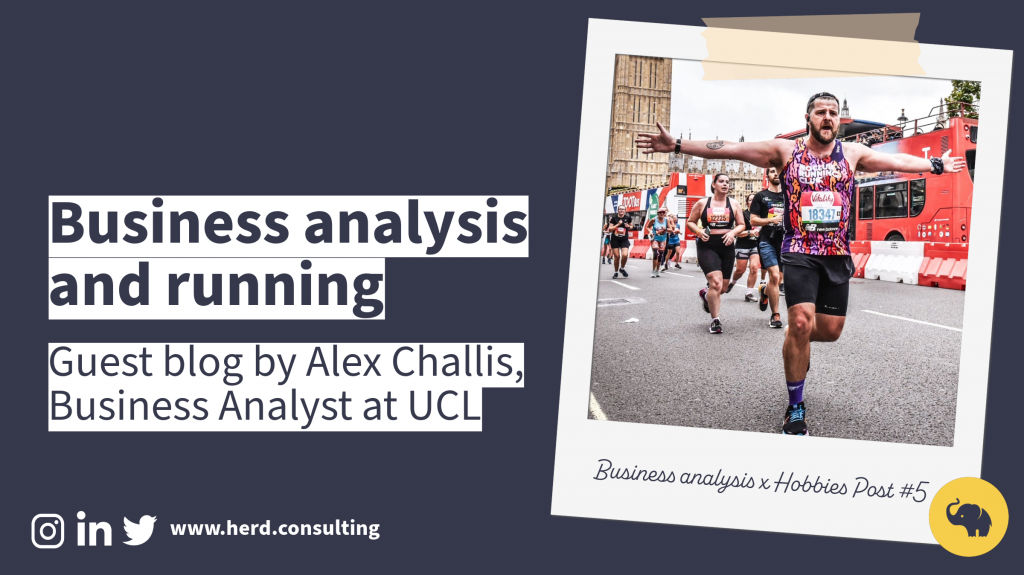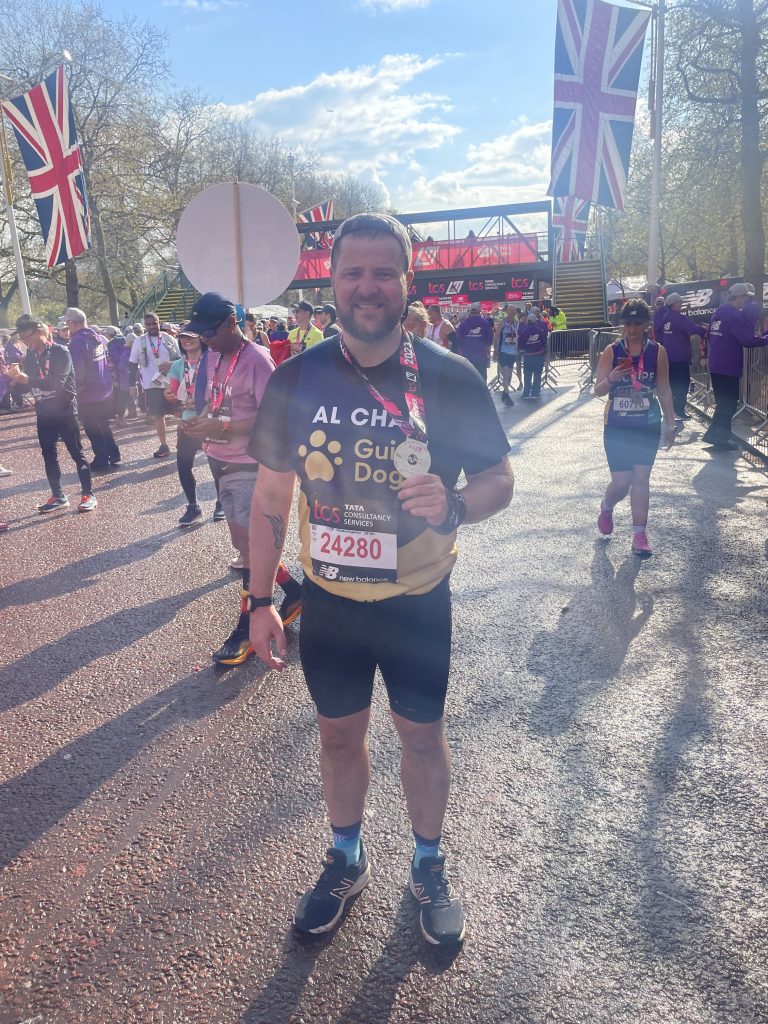
This is our fifth blog post in our hobbies x business analysis series. Well done to our friend of Herd, Alex Challis, Business Analyst at University College London. It’s a brilliant read. If you’d like to join our growing list of guest bloggers then please get in touch.
Introduction
Business analysis often involves a fair bit of figuring out ‘stuff’ and undertaking tasks and using techniques that to colleagues unfamiliar with the profession might seem a bit abstract and leave them asking the question of ‘Why?’.
Yet it is the ‘Why?’ question that forms a fundamental part of the toolkit and skillset that business analysts use to get to the bottom of things and provide clarity, understanding and options. I want to explore 3 lessons learned from working as a business analyst, and how these principles can applied to my favourite hobby, running, and vice versa. Better business analysis and running experiences come about through having a plan, embracing the ‘suck’ and individually being the architects of the change that we want to see.

‘’Stick to the Plan. Anticipate, Don’t Improvise”
‘The Killer’ (Michael Fassbender) in the film The Killer (2023) – available on Netflix.
In Business Analysis, there is a need for us to try and get an initial sense of the organisation’s plan and the problem to be solved without necessarily knowing what form this is going to take. This situation is likely to become clearer over time as information gleaned from stakeholders, systems and processes is synthesised to ascertain wants, needs and gaps.
In turn, a plan of actionable tasks specific to the assignment materialises as your dataset becomes richer as you discover and explore further. Imagine yourself as a gold panner as the more information and data that you collect, the more golden nuggets you are able to filter and extract to assist in your understanding of trying to build the right thing, AND to build the thing right.
Whilst no two projects or assignments are ever the same, the overall approach and plan remains the same; good business analysis will always have a plan that consists of the following aspects:
- Investigation (of the Current Situation)
- Consideration (of Perspectives)
- Analysis (of the ‘Gaps’)
- Evaluation (of the Options)
- Definition (of the Requirements)
- Delivery (of the Change)
Sticking to this approach, and working through each of these stages, gives the best possible chance of anticipating any prospective scenarios (expected and unexpected) that need to be addressed.
As a runner training for their first marathon (I completed the London Marathon in April 2023), I followed a similar approach. I needed a plan to get me to the start line in the best possible shape. I investigated my current fitness and took advice from a number of websites, books and articles to ascertain what training plan was right for me.
I assessed my options and plumped for Run Less, Run Faster to fit around my life with a 3 runs a week plan, that gradually increased my distance and intensity week-by-week, so as to minimise and prevent injury as much as possible.
I stuck to the plan, but anticipated where I could. When I had pulled my calf, I adjusted accordingly and reduced intensity, took some rest and listened to my body. I trusted the process and got the result I wanted.
Getting comfortable with being Uncomfortable
Signing up to your first marathon is a daunting, but exciting experience. The fear of the unknown and propelling your body at a speed and distance that hasn’t been experienced before can feel insurmountable. But learning to ‘embrace the suck’ and enjoying the journey and process is just as important as having and sticking to a plan.
It also helps when you know your purpose. I ran my first marathon for Guide Dogs for the Blind charity and raised over £2.5k in the process. Every time I had a bad run, or it was hurting and I was absolutely spent and felt I couldn’t go on, I thought about how my efforts were going to benefit the work of this wonderful charity. The temporary pain and suffering was definitely worth it.
But after completing the marathon, I knew I wasn’t done and this in some ways was the beginning of my running journey. I somehow knew that this would be the first of many marathons. Yet, the purpose of future races would be me. I had proved to myself that I could do it, but could I continue to challenge myself and continue to face adversity and grow in the process? Only time will tell, but I will take comfort in the effort and exertion.
In business analysis, there have been occasions where I have felt uncomfortable; parachuted into a project to try and make sense of a scenario where there is a resistant stakeholder or reluctance to engage or a misunderstanding of the issue at hand. Or volunteering to provide assistance on an assignment only to find that the frustrations outweigh the benefits. It is only through these experiences that you become more resilient and less fazed about current and future scenarios. Current uncomfortableness allows for future growth and development and the new benchmark to progress from.

Own the Change, by being the Change you want to see
I have always looked to be fit and active since I was young but given my stocky build I have always had issues with my weight, which I have perennially struggled with. Where I once utilised my weight and shape in playing rugby into my 20’s, I found once my playing days were over (shoulder and upper back issues) I found the weight hard to keep in check. My knees were and still are in good condition and decided that running was something I could incorporate into my fitness regime.
As my running progressed, so did my fitness and my body shape as the weight started to fall off and increased my muscle mass at the same time. But in order to keep it going and continuing to progress, I needed to find a way to keep it going and signing up for more and longer running events. I also joined a local running club (Tooting Run Club) to run with others and make training more fun and sociable, but also to unconsciously hold me to account. The unexpected bonus was a number of people that I run with have now become amazing friends, making it even easier to keep me motivated and to provide encouragement and support to them as well.
Similar to looking to get uncomfortable in order to grow, as a business analyst we sometimes need to become the change we want to see for a particular project if we identify an opportunity that will benefit it. Maybe it’s not necessarily seen to be part of our job role and responsibilities and taking on additional tasks or speaking up to say that something isn’t working and missing and providing an idea or rationale to rectify and change. Maybe this makes us unpopular with stakeholders and perceived by colleagues as being difficult, but the fact that you are raising it shows you are being divergent in your thinking and providing alternatives to the status quo. We’re just using our toolkit and soft skills to try and steer the project/assignment to an optimal series of outcomes at the end of the day.
‘When all think alike, then no one is thinking’ the American journalist Walter Lippman famously once said. Being more ‘Walter’ in certain circumstances as a business analyst and as a runner is sometimes necessary to instigate and deliver the change you want to see.
If anyone fancies a brew and a natter about their hobbies and interests, or to even chat through our range of business analysis & product management services, drop us a message. We’ve got posh coffee (Darkwoods) and Chocolate Hobnobs.
🖊️ Authored by: Alex Challis, Business Analyst, University College London (UCL)
🎧 Most listened to song in the run up to the London Marathon in 2023: “Everybody Wants To Rule The World” by Tears for Fears
For all the latest updates